“Global Emergency Department Information System Market to reach a market value of USD 2.2 Billion by 2031 growing at a CAGR of 13.8%”
The Global Emergency Department Information System Market size is expected to reach $2.2 billion by 2031, rising at a market growth of 13.8% CAGR during the forecast period.
Europe is at the forefront of adopting advanced healthcare technologies, including artificial intelligence, machine learning, and telemedicine. EDIS systems incorporating these technologies are increasingly in demand to enhance clinical decision-making and patient care. Thus, the European region would acquire nearly 27% of the total market share by 2031.
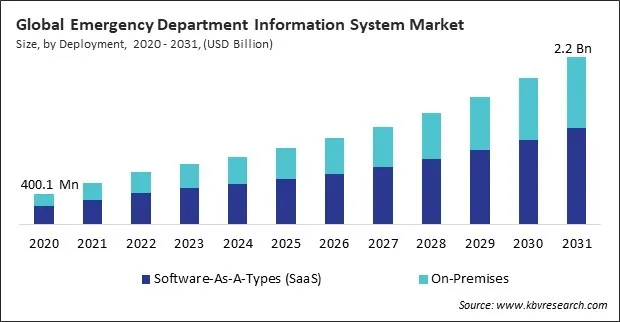
The major strategies followed by the market participants are Partnerships as the key developmental strategy to keep pace with the changing demands of end users. For instance, in March, 2023, Veradigm, Inc. signed a partnership with Opargo, a patient scheduling solutions provider, to integrate its Practice Management suite with Opargo's scheduling and revenue optimization offerings. The combined expertise of the two companies would facilitate their customers to improve their practice and schedule efficiency. Moreover, in October, 2022, Cerner Corporation, a subsidiary of Oracle Corporation, partnered with Validic Inc., a digital healthcare solutions provider, to integrate its offerings with Validic's integrated digital health solutions. The partnership would facilitate the joint customers of the two companies in the efficient management of population-wide chronic conditions.
Based on the Analysis presented in the KBV Cardinal matrix; Cisco Systems, Inc. is the forerunner in the Market. Companies such as Oracle Corporation, Medtronic PLC, Getinge AB are some of the key innovators in Market. In November, 2022, Cerner Corporation, a subsdiary of Oracle Corporation, partnered with Labcorp, a life science company, to provide solutions for efficient healthcare operations workflow. The partnership would facilitate the customers of the two companies to automate certain parts of their laboratory operations.
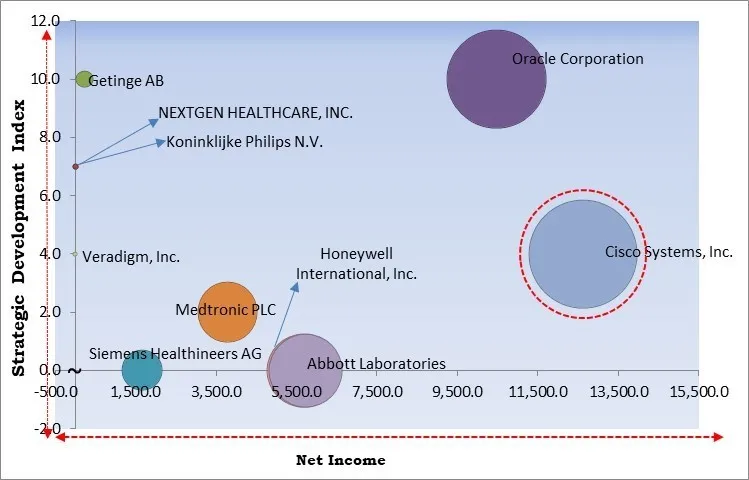
In emergency departments (EDs), timely and accurate communication among healthcare providers is essential for managing patient care efficiently. EDIS enhances the accuracy of patient records by automating data entry and reducing reliance on manual documentation. Therefore, the rising need for improved patient care and safety drives the market’s growth.
The focus on reducing Emergency Department (ED) wait times is a significant driver for the market’s growth. EDIS automates manual tasks such as data entry, patient registration, and order processing. By reducing the need for manual input, the system accelerates administrative processes and reduces patients’ time waiting for care. Thus, the focus on reducing ED wait times is propelling the market’s growth.
Acquiring an EDIS involves substantial software licensing costs. These fees can be high, especially for advanced systems with comprehensive features and functionalities. Effective use of EDIS requires comprehensive training for emergency department staff, including doctors, nurses, and administrative personnel. Thus, high implementation costs are hampering the market’s growth.
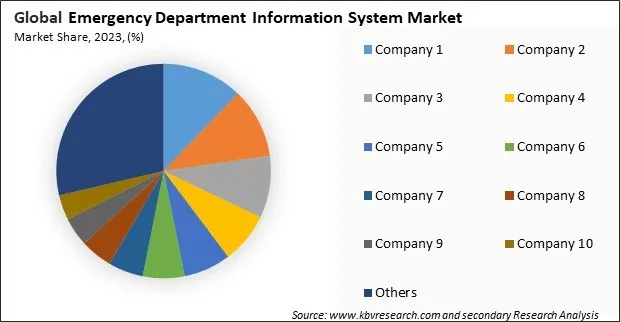
The leading players in the market are competing with diverse innovative offerings to remain competitive in the market. The above illustration shows the percentage of revenue shared by some of the leading companies in the market. The leading players of the market are adopting various strategies in order to cater demand coming from the different industries. The key developmental strategies in the market are Partnerships & Collaborations.


Based on deployment, the market is divided into software-as-a-types (SaaS) and on-premises. The on-premises segment attained 40% revenue share in the market. Some emergency departments prefer on-premises EDIS due to data security and privacy concerns. On-premises solutions allow departments to keep sensitive patient information within their facilities, minimizing the risk of data breaches that could occur with cloud-based systems.
By end-user, the market is divided into medium-sized hospitals, large hospitals, and small hospitals. The large hospitals segment procured 36% revenue share in the market in 2023. Large hospitals often experience high patient volumes in their emergency departments. EDIS helps manage this influx efficiently by streamlining patient flow from registration and triage to treatment and discharge or admission, reducing bottlenecks and wait times.
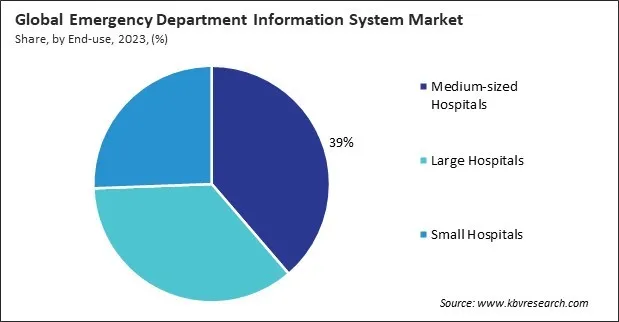
On the basis of type, the market is segmented into best of breed (B.O.B.) solutions and enterprise solutions. In 2023, the enterprise solutions segment attained 46% revenue share in the market. Enterprise EDIS solutions offer a unified platform that integrates seamlessly with other hospital systems, such as Electronic Health Records (EHRs), Laboratory Information Systems (LIS), and Radiology Information Systems (RIS).
Based on application, the market is categorized into computerized physician order entry (CPOE), clinical documentation, patient tracking & triage, e-prescribing, and other applications. The clinical documentation segment witnessed a 20% revenue share in the market in 2023. Advanced clinical documentation systems ensure that all relevant patient information is accurately and comprehensively recorded. This includes vital signs, treatment administered, patient history, and other critical data essential for high-quality care and accurate medical records.
Free Valuable Insights: Global Emergency Department Information System Market size to reach USD 2.2 Billion by 2031
Region-wise, the market is analyzed across North America, Europe, Asia Pacific, and LAMEA. The North America region witnessed 43% revenue share in the market in 2023. North America, particularly the United States and Canada, boasts the most advanced healthcare systems in the world. The presence of well-equipped hospitals, cutting-edge medical facilities, and a focus on quality care creates a conducive environment for adopting sophisticated EDIS solutions.
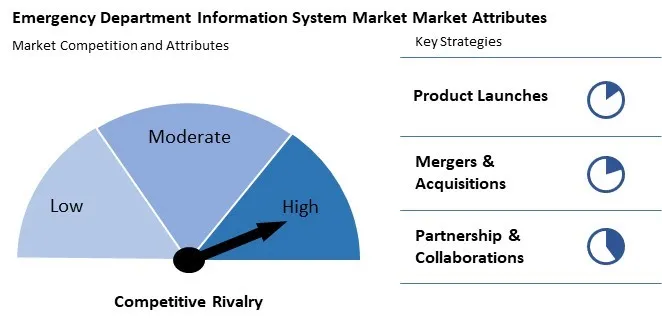
The market is highly competitive, with key players offering advanced, integrated solutions for efficient patient management. Competition revolves around features like real-time data sharing, interoperability, and regulatory compliance, driving innovation.
| Report Attribute | Details |
|---|---|
| Market size value in 2023 | USD 789.8 Million |
| Market size forecast in 2031 | USD 2.2 Billion |
| Base Year | 2023 |
| Historical Period | 2020 to 2022 |
| Forecast Period | 2024 to 2031 |
| Revenue Growth Rate | CAGR of 13.8% from 2024 to 2031 |
| Number of Pages | 310 |
| Number of Tables | 443 |
| Report coverage | Market Trends, Revenue Estimation and Forecast, Segmentation Analysis, Regional and Country Breakdown, Competitive Landscape, Market Share Analysis, Porter’s 5 Forces Analysis, Company Profiling, Companies Strategic Developments, SWOT Analysis, Winning Imperatives |
| Segments covered | Deployment, End-user, Type, Application, Region |
| Country scope |
|
| Companies Included | Oracle Corporation, Siemens Healthineers AG (Siemens AG), NEXTGEN HEALTHCARE, INC. (Thoma Bravo), Koninklijke Philips N.V., Cisco Systems, Inc., Medtronic PLC, Abbott Laboratories, Honeywell International, Inc., Getinge AB and Veradigm, Inc. |
By Deployment
By End User
By Type
By Application
By Geography
This Market size is expected to reach $2.2 billion by 2031.
Rising need for improved patient care and safety are driving the Market in coming years, however, High implementation costs of EDIS restraints the growth of the Market.
Oracle Corporation, Siemens Healthineers AG (Siemens AG), NEXTGEN HEALTHCARE, INC. (Thoma Bravo), Koninklijke Philips N.V., Cisco Systems, Inc., Medtronic PLC, Abbott Laboratories, Honeywell International, Inc., Getinge AB and Veradigm, Inc.
The expected CAGR of this Market is 13.8% from 2024 to 2031.
The Software-As-A-Types (SaaS) segment is generating the highest revenue in the Market by Deployment in 2023; thereby, achieving a market value of $1.3 billion by 2031.
The North America region dominated the Market by Region in 2023, and would continue to be a dominant market till 2031; thereby, achieving a market value of $908.9 million by 2031.
Our team of dedicated experts can provide you with attractive expansion opportunities for your business.
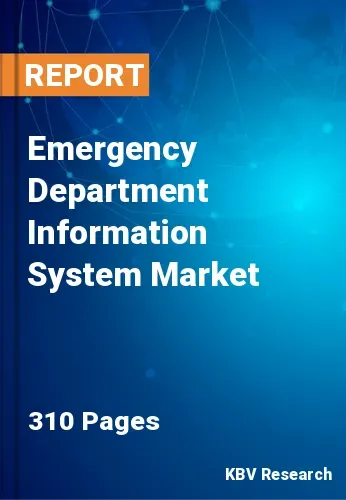
 Drivers
Drivers
 Restraints
Restraints
 Opportunities
Opportunities
 Challenges
Challenges
